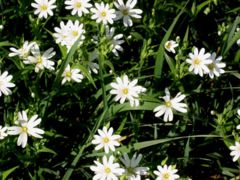Stellaria holostea
| Stellaria holostea subsp. var. | Addersmeat, Greater Stitchwort, Easter Bell | |||||||||||||||||||||||||||||||||||||||||||||||||||||||
|---|---|---|---|---|---|---|---|---|---|---|---|---|---|---|---|---|---|---|---|---|---|---|---|---|---|---|---|---|---|---|---|---|---|---|---|---|---|---|---|---|---|---|---|---|---|---|---|---|---|---|---|---|---|---|---|---|

|
|
| ||||||||||||||||||||||||||||||||||||||||||||||||||||||
| ||||||||||||||||||||||||||||||||||||||||||||||||||||||||
Stellaria holostea (Addersmeat, or Greater Stitchwort) is an ornamental plant native of Europe.
It can grow up to 50cm in height, with leaves that are long, narrow and fresh green.[1] The flowers are white, 20-30mm across and have five distinctive petals split to about half way down.[1][2]
| Standard Cyclopedia of Horticulture |
|---|
|
Stellaria holostea, Linn. Easter Bell. A hardy perennial, erect, 6-18 in. high, simple or somewhat branched, from a creeping rootstock: lvs. sessile, lanceolate, 1-3 in. long: fls. white, abundant, in a terminal leafy panicle; sepals one-half or two-thirds as long as the petals. May, June. Eu., Asia.—This and the next are desirable for dry banks where grass will not grow well and for other carpeting purposes. CH
|
Cultivation
Propagation
Pests and diseases
Varieties
Gallery
-
photo 1
-
photo 2
-
photo 3
References
External links
- w:Stellaria holostea. Some of the material on this page may be from Wikipedia, under the Creative Commons license.
- Stellaria holostea QR Code (Size 50, 100, 200, 500)
